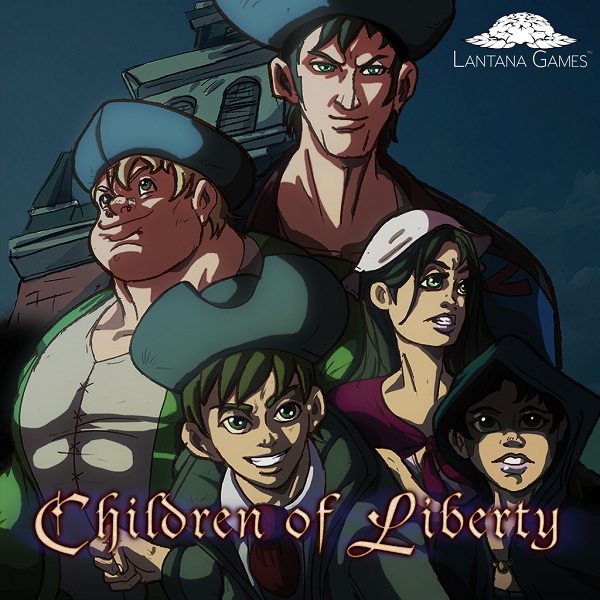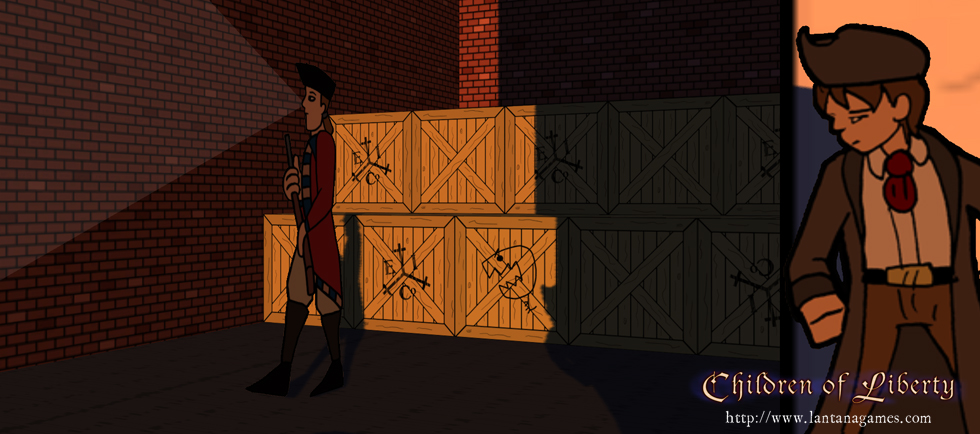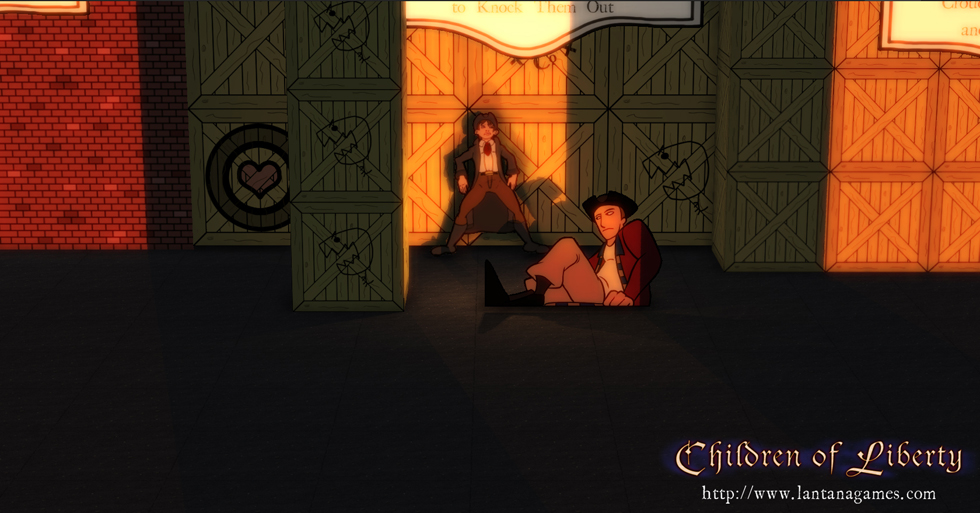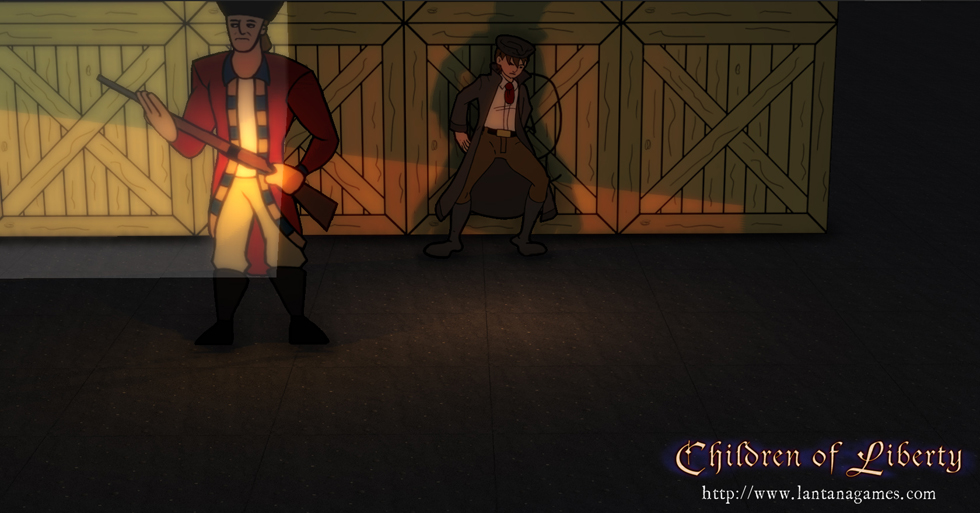Last updated on April 3, 2013
I’ve already written about Children of Liberty on Substance TV, but mostly to promote it for the Greenlight campaign. I’d like to get a little more in-depth with the game itself, however. I did actually buy it at PAX East, and that was the only “swag” I found at the show (I guess I’m just slow or I don’t want a bunch more possessions to add to my stockpile of other possessions). Still, having talked with the lead game designer Dan Silvers and playing it, I figure it’d make a lot more sense to talk in that way.
As far as story and setting, you’d be remiss in thinking that Children of Liberty somehow stole its setting and ideas from Assassin’s Creed III – after all, it would seem that Lantana Games wants to capitalize on the idea of a Revolutionary War game (and maybe make a good one, finally!). However, Lantana Games hails from Boston, and their initial goal came from an opportunity to create an educational game for the Minuteman National Historic Park. As concepts began to form and mechanics gestate, they found that it wasn’t suitable for a simple website game, So they decided to strike out on their own and make a real stealth-action game out of the mix.
I asked Mr. Silvers more than a few questions (as in, I ask WAY TOO MANY QUESTIONS), and he obliged my “completionist” nature:
What was the genesis of the game itself?
The game was born as I was graduating from the Savannah College of Art and Design. A bunch of friends of mine, including one Samuel Paley who’d go on to be our producer from 2010 to 2012, and I met up at the computer lab and started discussing an opportunity I’d been presented with – to make games based on the American Revolution for the Minuteman National Historic Park in Boston. Though the ideas we came up with that day have nothing to do with what Children of Liberty is today, that was the start of it. The Park Service actually never ended up having any money for Children of Liberty, but I ran away with it since I had fallen in love with the concept.
What’s the plot of the game? Is there any particular message you want to get across, or is it just having fun with the historical setting?
The plot follows four kids on the eve of the American Revolution. Their parents arrested, they join the Patriots to assist in efforts to uncover the details of a conspiracy headed by William Legge, the Earl of Dartmouth, and Royal Governor Thomas Gage, in exchange for the Patriots helping them break their parents out of jail. The message we want to get across is that games can be educational without sacrificing the fun. The old MECC and Learning Company games come to mind, like Number Munchers (Editor’s Note: Theology Gaming GOTY 1988) or the Super Solvers series. Those are games I grew up with, and you don’t hear too much these days about games made in that style. My childhood would not have been the same without positive gaming experiences like those, and I think indie development has really yet to stake a claim in that area. I’m hoping to change that.
Why stealth? Why children as the protagonists? And why the lack of, shall we say, violent death (at least as far as the demo goes)?
Because stealth is awesome, and kids are naturally sneaky. Some of the most revered games are stealth games, like Thief and Deus Ex. It’s a very intimidating genre to enter, especially when Mark of the Ninja set the bar for 2D stealth so high. So naturally the question becomes, “What can we do to set ourselves apart, to have our own voice, but still pay close attention to the lessons taught by those games that came before ours?” As for why kids, several reasons. One, there were many kid spies running around Boston working for the Patriots at the time, and that level of bravery goes beyond what any multicultural man in a white hooded cloak can give you. Second, there are not a lot of games that star kids these days, even though just twenty years ago we had the likes of Commander Keen and Link in his childhood years. I’m pretty certain kids can relate more to playing as other kids than they can big, hulking, machismo, gun toting, cigar smoking mass murderers. For Children of Liberty, we knew kids wouldn’t have the strength to kill soldiers, and soldiers (you’d hope) would have enough of a moral fiber to not kill kids. Non-lethal takedowns not only allowed for this, but also for the AI to wake each other up and potentially get into hilarious conversations about why they’re sleeping on the job. Plus, guards being knocked out is a good excuse to throw in birds circling their heads, Chuck Jones style.
Do you think the comparisons to Metal Gear Solid (which I’ve heard A LOT) ring true, or do you guys have a different set of inspirations other than stealth-action games (and if so, list them and describe why they work that way)?
Hey if anyone really wants to compare our game to Metal Gear Solid, I’ll take it! It was, after all, MGS2 that had peeking around corners to see who’s coming; the only difference in Children of Liberty is that you’re peeking into an oncoming 2D gamespace. It hurts my head when I think about it, but then I just remind myself that this really isn’t a 2D game we’re making: it’s a 3D game that, 90% of the time, plays in 2D. I think our inspiration comes from three places: stealth games, cartoons, and our beautiful city of Boston. Stealth games like Deus Ex, Metal Gear Solid, Mark of the Ninja, and the recent Batman games have played a huge part in crafting the mechanics of Children of Liberty, but I think what separates us is not only the binary notion of stealth (like Mark of the Ninja) but also the continued freedom of movement while hidden. As for cartoons, I’m just getting out of a gigantic Animaniacs and Freakazoid kick, but I think I’m alone on the team for those. Otherwise our cartoon tastes are eclectic, including but not limited to Futurama, Regular Show, Foster’s Home for Imaginary Friends, Billy and Mandy, The Venture Bros., and Metalocalypse. As for Boston, well, it’s Boston and it’s barely changed since 1630. Very convenient for reference photos and level design.
Can you share some of the mechanics design with us? Why the dual-plane usage? Is it intentional that you can’t see guards around corners? What is the purpose of the double jump? Also, how do I hang off ledges?
Well, as you know, the game is still in alpha, so everything you see is subject to change, especially the not-being-able-to-see-guards-around-corners thing. That’s all a matter of time and money, of which we have none. We spent a year prior to this last PAX rebuilding the game from the ground up, so being able to see various sides of enemy sprites wasn’t the biggest priority. It’s obviously on our to-do list. The dual-plane usage just came out of the fact that we were building the game in Unity with a perspective camera. It was like, we can see these areas, why exactly can we not check them out? After not being able to come up with a good reason, we iterated three or maybe four different versions of moving the camera and the player onto the different tracks in each level. It then became a matter of blending the stealth into the turns, which has been executed thanks to the corners (peeking, takedowns, and some more things on the way). The double jump is one of the few original abilities of a character left in the game. Joseph has had it since I built the original prototype. All characters have their own jumping abilities, like Joseph’s Double Jump, or Doug’s Ground Slam. Ally’s used to be a “Princess Float” but now we’re playing around with new ones for her and Sarah. We want to make sure that each character’s abilities make the game a different experience on each playthrough. Hangers are auto triggered, just jump to them. Within the next few updates we’ll have shimmying built back in too, so you’ll be able to move left and right on certain hangers.
How will multiple characters change the basic design of the game? What’s the fundamental (or planned) difference between them? Do they all play the same stages?
Each of the characters play the same stages, but you’ll have to approach them in different ways thanks to their varied skillsets. It’s impossible to pin down just one difference between all of them because there are so many, and those differences will lead toward not only different styles of platforming, but also different styles of stealth. For instance, Ally is our freerunner, so we’ve brainstormed on how we can use her speed to gain a stealthy advantage over enemies. Balancing the game with these four kids is a huge undertaking, but luckily now that the core gameplay is in, we can focus on tweaking it and changing bits and pieces of it for the other three kids.
Who came up with the lovely art style? Was there anything in particular that led to the adoption of said art style?
The style for the kids was defined by the wonderful Jess Gutierrez, our concept artist who was with the team briefly in 2011. She came on board as we were reinventing the game and drew nearly a dozen character designs. Our animators Michael Winn and Ricky Bryant Jr. were then able to interpret those designs and bring them to life. I think the reason we went with the hand drawn style was mainly because of our love of cartoons, but also because as soon as we saw the effect of realtime shadows on a hand drawn sprite, there was no going back.
So what’s the overall goal for the game, the overarching idea that you hope people get from the whole thing when it comes out?
If you ask me, the industry is headed in some very strange directions at the moment. There is a lot of pent up anger, a lot of frustrated people, and a whole lot of uncertainty. The only thing anyone knows is people still like games, they still like stories, and if Bioshock Infinite has proved anything, it’s that people L-O-V-E love great games with great stories. That’s really all I’m trying to do, is to be a storyteller, and games are my way of telling the stories I want to tell. My only hope is that when people play the game, they’re left smiling. Every creative work these days is all about making it darker and grittier, Christopher Nolan style. Don’t get me wrong, I love the new Batman films, but at a certain point I think all this brooding starts to eat away at us. Let’s lighten up and have some fun.
Is there an approximate release date for the game, and how close is it to completion?
No release date yet. We’re currently bankrupt and looking for ways to keep the project alive.
Is the Desura demo representative of the final product, or is it merely a proof of concept?
At this point it is much more representative of the final product than it was a year ago but, again, still not final. I’m hoping we can get updates out more often than once a year though. We had so much to rebuild after PAX 2012 that an update would have just been a developer console filled with errors. But now it is smooth, speedy, solid, and stealthy. I’m hoping that with enough community support on our Desura and Steam Greenlight that we can keep building the game, upgrade the engine to Unity 4, and port the game to Linux and other platforms. As it stands, we have around 2000 frames of hand drawn animation; over an hour of recorded dialog; countless models, textures, and environmental sprites; and a 215 page development bible. It’ll get done, it’s just a matter of making sure rents get in on time, families get fed, and debts are repaid.
Are you interested in fan feedback, and where can we send said feedback?
Absolutely! We love our fans and write down every piece of feedback we get. Make sure to visit www.childrenofliberty.us to learn more about the game, and get in touch on our Facebook (/lantanagames), Twitter (@lantanagames), or email contact@lantanagames.com with any general inquiries/comments. We can’t finish this game without our incredible fans having our backs.
———————————————————————————————————————————————————————————————————————–
I was taken aback by the educational game aspect. Some of my fondest memories come from playing the Reading Blaster 9-12 game (because, let’s face it, grade school math wasn’t all that interesting!) and Carmen Sandiego. Plus, you could get away with learning and playing at the same time – in a Christian school, that worked wonders! Of course, Children of Liberty looks to fulfill both the mechanical and educational requirements all at the same time while still being kid friendly – what a contrast from our current game market!
Teach your children to learn when they’re young, and they eventually develop a voracious appetite for it – I should know, I’m a product of such a home. Proverbs 31 gives us an inkling of this:
My son, do not forget my teaching,
But let your heart keep my commandments;
2 For length of days and years of life
And peace they will add to you.
3 Do not let kindness and truth leave you;
Bind them around your neck,
Write them on the tablet of your heart.
And it starts when you’re a kid. Your beginning doesn’t determine your future, but it sure does set good precedents! I would hope Children of Liberty fulfills its goals of lighthearted, yet educational, fun. We need more of that in the world of the “dark and gritty” variety!




